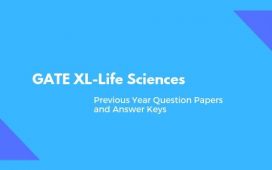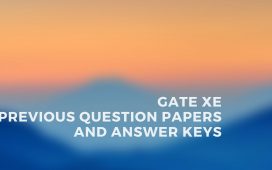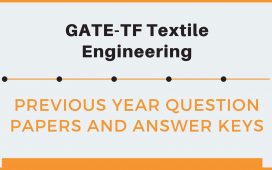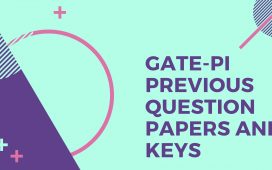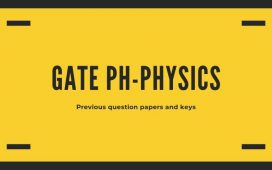GATE – Graduate Aptitude Test in Engineering is an all India examination jointly by the IISc (Indian Institute of Science) and the seven IITs (Indian Institutes of Technology) on behalf of the National Coordination Board – GATE, Department of Higher Education, Ministry of Human Resource Development (MHRD), Government of India.
The score of GATE examination can be used by the students for admissions to various post-graduate programmes like M.E., M.Tech. These scores are valid for three years post announcement of results. The score can also be used by Public sector units for the purpose of employment screening.
About GATE 2020 CY Exam:
The GATE 2019 examination is for 3 hours and the question paper consist of 65 questions for a total of 100 marks. The mode of examination is ONLINE and at the end of 3 hours, computer will automatically close the screen ending the examination.
Pattern of the CY GATE 2020 Question Paper:
The GATE 2019 Chemistry Exam Paper would contain 25 Questions of 1-mark each and 30 questions of 2-marks each. Out of the 65 questions asked, 10 questions would be General Aptitude and the rest 55 would be subject based questions. The questions are from Physical, Organic and Inorganic Chemistry.
The exam contains two different types of questions:
(i) Multiple Choice Questions (MCQ)
Each MCQ would carry 1 or 2 marks each in all the papers and sections. These questions are objective in nature, and each will have a choice of four answers, out of which the candidate must choose the correct answer. Note that there will be negative marking for a wrongly selected answer.
(ii)Numerical Answer Type (NAT) Questions
Each NAT question carry 1 or 2 marks each in all the papers and sections. For these questions, the answer is a signed real number, which needs to be entered by the candidate using the virtual numeric keypad on the monitor (keyboard of the computer will be disabled). No choices will be shown for these types of questions. The answer can be a number such as 10 or -10 (an integer only). The answer may be in decimals as well. There is no negative marking for a wrong answer in NAT questions.
GATE 2020 CY Syllabus:
-
Section 1: Physical Chemistry
Structure: Symmetry elements and operations, Einstein coefficients. Postulates of quantum mechanics and Chemical bonding.
Equilibrium: Laws of thermodynamics, Thermochemistry. Thermodynamic functions, Gibbs-Helmholtz and Maxwell relations, van’t Hoff equation.
Kinetics: Transition state theory, Kinetics of photochemical and photophysical processes, Unimolecular reactions.
Surfaces and Interfaces: Langmuir, Freundlich and BET isotherms. Surface catalysis, Physical chemistry of colloids, micelles and macromolecules.
-
Section 2: Inorganic Chemistry
Main Group Elements: Hydrides, halides, oxides, oxoacids, nitrides, sulfides – shapes and reactivity, Allotropes of carbon.
Transition Elements: Coordination chemistry – structure and isomerism, Electronic spectra of transition metal complexes, Orgel diagrams.
Lanthanides and Actinides: Recovery, Periodic properties, spectra and magnetic properties.
Organometallics: 18-Electron rule, Homogeneous catalysis, Heterogeneous catalysis, Tropsch reaction, Ziegler-Natta polymerization.
Radioactivity: Decay processes, half-life of radioactive elements, fission and fusion processes.
Bioinorganic Chemistry: Ion transport, oxygen binding, nitrogen fixation, metalloenzymes containing magnesium, molybdenum.
Solids: Crystal systems and lattices, Miller planes, crystal packing, Bragg law,band theory.
Instrumental Methods of Analysis: NMR and ESR spectroscopy, mass spectrometry. Electroanalytical methods, Thermoanalytical methods.
-
Section 3: Organic Chemistry
Stereochemistry: Chirality of organic molecules, Relative stereochemistry, Homotopic, enantiotopic and diastereotopic atoms, Geometrical isomerism.
Reaction Mechanisms: Hammond’s postulate and Curtin-Hammett principle, Nucleophilic and electrophilic substitution reactions, Elimination reactions and Re-active intermediates.
Organic Synthesis: Carbon-carbon bond formation through coupling reactions, Concepts of asymmetric synthesis, Michael addition reaction, Stereoselective addition.
Pericyclic Reactions and Photochemistry: Electrocyclic, cycloaddition and sigmatropic reactions, Orbital correlations, Photooxidation and photoreduction.
Heterocyclic Compounds: Structure, preparation, properties and reactions of furan,Pyrrole and isoquinoline.
Biomolecules: Structure, properties and reactions of mono- and di-saccharides, physicochemical properties of amino acids, chemical synthesis of peptides.
Spectroscopy: Applications of UV-visible, IR, NMR and Mass spectrometry in the structural determination of organic molecules.
For detailed syllabus, click on GATE 2020 CY Syllabus
GATE CY Previous Year Solved Papers:
| Sl. No | Year of GATE CY Exam | Download Link of Solved previous year CY Papers |
| 1 | 2019 | Download |
| 2 | 2018 | Download |
| 3 | 2017 | Download |
| 4 | 2016 | Download |
| 5 | 2015 | Download |
| 6 | 2007-2014 | Download |


